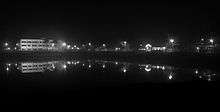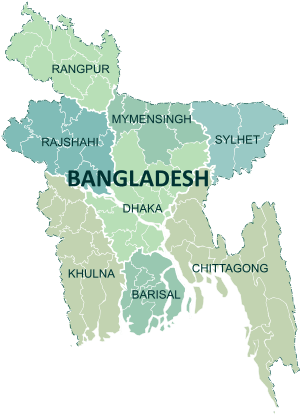Madaripur District
| Madaripur মাদারিপুর | |
|---|---|
| District | |
 Location of Madaripur in Bangladesh | |
| Coordinates: BD 23°10′N 90°06′E / 23.17°N 90.10°ECoordinates: BD 23°10′N 90°06′E / 23.17°N 90.10°E | |
| Country |
|
| Division | Dhaka Division |
| Area | |
| • Total | 1,144.96 km2 (442.07 sq mi) |
| Population (2011 census) | |
| • Total | 1,212,198 |
| • Density | 1,100/km2 (2,700/sq mi) |
| Time zone | BST (UTC+6) |
| Postal code | 7900 |
Madaripur (Bengali: মাদারিপুর ), being a part of the Dhaka Division, is a district in central Bangladesh.[1]
Website: http://www.madaripur.gov.bd
History of Madaripur
Madaripur subdivision was established in 1854 under the district of Bakerganj. In 1873 it was separated from Bakerganj and annexed to Faridpur district. Madaripur subdivision was turned into a district in 1984. Madaripur district was named after Sufi saint 'Sayed Badiuddin Zinda Shah Madar' (d. 1434 CE). He was one of the Sufi saints who came to Bangladesh from some Middle Eastern country in the 14th century to propagate Islam in Bengal. Shah Madar's dargah or tomb on the bank of the Arial Kha is visited every year by countless people seeking the blessings of the saint. The Madaripur Sadar was established by Ishan Chandra Sen, the Sengupta family. His son Ramesh Sen was head of the Madaripur Municipality later. Ramesh Sen's son was a freedom fighter from Madarpur. His son-in-law Gangacharan Dasgupta led the National University movement.
One of the most important historical events that took place in Madaripur is the Faraizi Movement led by Haji Shariatullah (1781–1840). During the War of Liberation many direct encounters were held between the freedom fighters and the Pakistan army in Madaripur. The freedom fighters of Madaripur captured 40 Pakistani soldiers including a major and a captain.[1]
Demographics
The total population is 1212198, among them: male 50.29% and female 49.71%. The religion of the majority of the people is Islam, but there are Hindus also. The specifications are: Muslim 75.67%, Hindu 23.72% and others 0.61%. Mosques 1844, temples 553 and churches 1.
Geography

Faridpur District and Padma River are on the north of the Madaripur district. Barisal is on the south, Shariatpur and Meghna River are on the east. Gopalgong District and Padma River are to its west. Madaripur (Town) consists of 9 wards and 33 mahallas. The area of the town is 34.81 square kilometres (13.44 sq mi). A few years before Madaripur was famous for Jute business and Jute industry, This was initiated before 1970 by one of the wealthiest Person A.R Howlader. After the independence of Bangladesh, government seized all large private industries and formed BJMC. The industry then became sick. Local political leaders are generated by that Jute mill. Because of the jute industries in Madaripur, it attracted many businessmen. It provided many jobs and comfort to the local peoples. After its success just before 2000, the business started to lose its profits.
Educational institutions
Among educational institutions, there are 17 colleges, 117 high schools, 437 government primary schools, 262 non-government primary schools, 6 kindergarten schools, 1 primary training institute, 1 vocational institute and 60 madrasas.
Government institute in madaripur: 1. Gov nazimuddin college,madaripurwww.gnc.gov.bd 2.Begum sufia gov girls college,madaripur 3.Gov Sheikh hasina academy & womens college,,dashar,madaripur
Subdivisions
Madaripur is divided into 4 Thanas
The largest city of the district is Madaripur Municipality
Administration
Economy
Main occupations Agriculture 33.32%, fishing 1.1%, agricultural labourer 23.53%, wage labourer 3.87%, industry 1%, commerce 11.98%, transport 1.93%, construction 1.19%, service 10.14%, others 11.94%.
Madaripur is famous for date molasses (pataligur). It is best in the country. It is sweet is also famous. There is a jute mill (AR Howlader Jute Mills)there. That jute mill is now abolished due to political crisis of the place and now it the safety zone for great monkeys. The Municipality graveyard, a mosque, an office of local police and RAB office is now in that place. A.R. Howlader is called as the founder of modern Madaripur.
Transportation
The total measurements of all kinds of roads are: metal 163 kilometres (101 mi), semi-metal 154 kilometres (96 mi) and mud 4,010 kilometres (2,490 mi).
NGOs
All the national NGOs Like ASA, Brac, TMSS, Proshika, CLG, Jagoroni Chakra Foundation are working in Madaripur. Madaripur Legal Aid Association is also a leading organization in Madaripur implementing initiatives to ensure legal services especially for the disadvantaged peoples. Est March 1978.
Madaripur Nari Unnayan Sangstha (MANUS) is working intensively for the improvement of the ultra poor marginalized under privileged woman to improve their socioeconomic condition through income generating activity, enterprise management, business skill development, saving, health and hygiene.
Aungkur Palli Unnayan Kendra
Aungkur Palli Unnayan Kendra, a centre for Rural Development, is a Bangladeshi, local, non-political, non-profit Development organization. It was established in 1989. It has been operating her development activities since 1991 under Madaripur District in Bangladesh and dedicated to the socioeconomic development of the poor specially the oppressed and exploited women folk in the development process and eventually challenges the unequal rural social order. APUK believes that the personal and institutional capacity building can explore and invent human potentialities to mobilize and manage resources for improving their quality of life so that they can establish sustainable and justifiable society.
During the last 20 years, Aungkur gathered diversified knowledge and skills about program planning, implementation, monitoring, action research study, and evaluation in the various fields of development, especially micro credit operation, capacity development. Adult literacy development program, Non formal Primary Education, safe water supply, Arsenic Mitigation, sanitation and hygiene promotion program including school sanitation and hygiene education. Aungkur also gathered both positive and negative experience through its development approaches.
Places of interest
The main places of public interests in Madaripur are Dargah of Shah Madar (Rh), Bajitpur Pronabanda Temple, Kadambari Ganesh Pagol Temple, Khalia Rajaram Roy's House, Kabirajpur Mia Bari (Zamidar bari), Mostafapur Parbat's Garden, Arial Khan River, etc. In the middle of the town, there is a large lake. This lake is one of the biggest lakes in Bangladesh. The Madaripur Lake (Shakuni Lake) has a great view. Madaripur district's mosque, Chowdhury clinic, Niramoy clinic, Madaripur Municipality, M.M. Hafiz Memorial Public Library, Officer's Club, Post Office, Madaripur Shilpakala Academy, Law College and District Shaheed Minar all are around the lake. During winter, the crop fields covered with yellow mustard flowers give a refreshing view, essence and the music of humming bees. The honey after the season, "mustard honey," is unique to the area. Also a lot of birds from many parts of the world spend the winter here, so the local lakes may be a good place to visit during that time.
Notable residents
- Mira Rani Devi: Author and social reformer
- Syed Abul Hossain: Politician and former minister for communications.
See also
References
- 1 2 Shahidul Haq (2012). "Madaripur District". In Sirajul Islam and Ahmed A. Jamal. Banglapedia: National Encyclopedia of Bangladesh (Second ed.). Asiatic Society of Bangladesh.
- ↑ http://www.thedailystar.net/newDesign/news-details.php?nid=214399
- ↑ http://www.madaripur.gov.bd/node/625885
External links
| Wikimedia Commons has media related to Madaripur District. |
